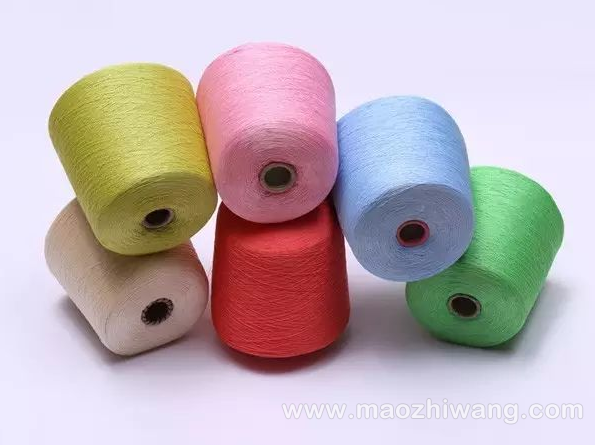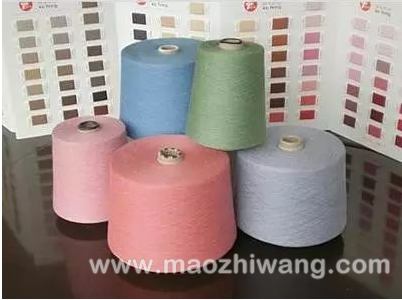
Different short fiber yarn technology has different effects on the physical properties and appearance of the yarn, and even affects the characteristics of the final product.
1 different spinning methods on the yarn structure
The structure of the staple fiber yarn is different from that of the filament, firstly the arrangement of the outer and inner fibers of the yarn, and the outer structure includes the appearance and surface texture of the yarn. Such as: the arrangement of fibers on the surface of the yarn; the hairiness of the yarn; the coefficient of friction of the yarn; the characteristics of the yarn; the wear resistance of the yarn and other characteristics of the surface.
2 yarn internal structure
Mainly the fiber is in the entire cross section of the yarn body and the longitudinal direction of the yarn. The fiber orientation, elongation, displacement and twist internal structure include: yarn strength; fiber mixing degree; bending strength; compressibility; rebound resilience Knot tends to ) . The above explanation of the structural implications is not necessarily complete, but provides the complexity of the yarn characteristics.
3 hairy
The flying flower and hairiness formed by spinning is a very troublesome problem. Many negative effects of hairiness in downstream processing, textile hand feeling and final product properties are affected by hairiness. The zweigle hairiness test is used to classify and divide 1-2 mm hairiness. Harmful hairiness above 3 mm. If the hairiness of the ring spinning yarn is 100%, the tight ring yarn, the vortex yarn and the rotor yarn 1-2 mm hairiness are reduced compared to the ring yarn, and the double nozzle is wrapped around the yarn, and the wrapping condition is poor. Many, the So-Called test can be used to measure the flying flower formed by the friction surface during the processing of the yarn, and the friction is measured by the rubber ring. Compact yarns have better anti-friction properties than non-traditional yarns. The rotor yarn has less hairiness, especially the viscose fiber, and the fiber on the yarn does not break, but many hairiness is wrapped around the yarn body, so the rotor yarn has less hairiness.
4 yarn volume
The yarn volume is an important indicator of the yarn covering ability. When the compact spinning ring yarn is the same as the ordinary ring yarn, the latter product has a lower covering ability. The compact spinning ring yarn can reduce the twist to increase the yarn volume under the condition of maintaining the same strength, and can obtain the covering ability equivalent to the ordinary ring yarn, and the twist can be reduced by 5-10%. Duncan doffer (Denkenolorr) yarn structure tester provides Found yarn volume yarn length of 0.3 mm. The yarn volume is detected by the same yarn count double nozzle MJS air-jet yarn. Since the air-jet yarn is wrapped yarn and false twisted yarn, the same yarn count is larger than the ring-shaped yarn, and the pattern photographed by microelectronic scanning photography shows A small amount of the wrapped fibers are on the core and the length is so short that many of the fibers of the yarn are substantially flawless.
The abrasion resistance and stress load of the warp yarns are applied to the So-Called analog index, and the 15 yarns required can be tested at the same time. The fiber arrangement of the ideal compact ring yarn is superior to that of a conventional ring yarn.
Non-traditional spinning technology has its shortcomings. This new type of spinning must be treated when it is used as a warp yarn. In the air-jet spinning technology, there are few fibers on the yarn relative to the real twisted yarn. Therefore, the mechanical properties of the yarn are different, especially when winding (complex ) , and the difference between non-conventional spinning and ring yarn.

5 yarn internal structure
The formation of the internal fibers of the yarn is related to the external structure of the yarn. The arrangement of the inner core of the yarn, the extension of the fiber along the length of the yarn can be obtained by electronic scanning photography during the drawing process, and the height of the fiber is seen from the cross section of the yarn. Parallel, and affect the strength of the yarn, the strength of the yarn is related to the length of the clamp during the test. Reduce the possibility of detail and strong weak loops.
The normal yarn strength was tested on a 520 mm strength machine with a clamping length of 100 mm and 18 mm. The clamping length is reduced and the yarn breaking strength is increased. This is because the clamping length is short, the probability of strong weak ring and detail is reduced, the breaking length is reduced, and the chance of breaking is small. If the fiber distribution orientation is good, the test clamping length is reduced, the yarn break length is significantly increased, and the ring yarn and the compact ring yarn are more conspicuous. The breaking strength of the rotor yarn is low, and even if the breaking length is lower than the fiber length, the breaking strength of the rotor yarn is not improved even if the breaking length is short due to the fiber forming the hook. In short, the more the yarn fibers are clamped, the better the longitudinal orientation of the fibers and the increased breaking strength of the yarn. It is seen from the post-electronography drawing that the rotor yarn is a wound structure, even if the clamping length is less than 5 mm, 100% of the fibers are clamped and the fiber is broken, the clamping length is 0 mm, and the fiber break length is lower than the fiber. The length and the poor orientation of the core fiber result in low strength.
The air-jet yarn is strong in the ring yarn, between the compact yarn and the rotor yarn, mainly the air-jet yarn. The yarn core is parallel to the rotor yarn, and the wrapping fiber is less, and the strength is less than the rotor.
6 yarn formation affects the characteristics of yarn deformation
If the yarn is resistant to bending, it is a characteristic that is affected during yarn formation, but it is difficult to detect the bending strength of the yarn. A new method for detecting the bending strength of yarns has been developed. Tests have shown that if the flexural strength of the compact yarn is 100%, the rotor spinning and eddy spinning are 200%, and the double nozzle air jet is 300%. These numerical relationships can be derived from some non-traditional spinning, in woven and knitted fabrics. Compared with the ring yarn, the fabric of the non-traditional spinning is rougher than that of the ordinary ring yarn, and the bending strength between the ordinary ring yarn and the compact yarn is also small.
In addition, there is a problem in that when the yarn is deformed, the yarn is deformed to be flattened after the yarn is pressed in the cross section of the warp and weft. The detection of the yarn thick section indicates that as the yarn compression force increases, the thick section decreases.
The structure of the rotor yarn causes a distribution of fibers. At the fiber wrapping, the hand feels harder, and the yarn has less deformation force than the yarn without the wrapping. Knitted fabrics and woven fabrics produced from rotor yarns tend to make the appearance uneven and stiffer than the ring yarn.
For comparison, the yarn thick section was tested under 100CN pressure conditions, indicating that the yarn has the best twist structure, and about 95% of the MTS double nozzle jet yarn of the same deformation is more likely to be deformed. According to this test, the rotor yarn feels harder, and the yarn deformation can be detected by the tightness of the yarn on the appearance of the loom or knitted fabric.
7 yarn resilience
The rebound of the yarn is very important for textile processing, for example, the knitted fabric is skewed. The resilience is measured by detecting the yarn kneading force. The resilience between the natural twist yarn and the non-traditional yarn of the compact ring yarn, the ordinary ring yarn is different, and the yarn of the rotor yarn is twisted or reversed. Both are lower.
The air-jet spinning has lower resilience, mainly because the proportion of parallel non-twisted fibers is higher, and the true crepe has a greater resilience than the non-conventional yarns, so the fabric is less skewed when further processed into knitted fabrics.
Yarn structure is one of the important characteristics of the yarn. The appearance of the yarn is related to the yarn properties. The fiber arrangement inside the yarn has a great influence on the yarn properties, especially the further processing of the yarn and the final product properties. The poor yarn structure has a great influence on the processing of the post-process. The applied yarn structure has a particularly good function and is also very useful. The textiles with tightly-spun yarns in the adaptation performance are ideal. There are currently five practical and highly regarded spinning methods in the field of cotton spinning, namely conventional ring spinning, rotor spinning, air jet spinning, vortex spinning and improved ring spinning – compact spinning. The ring spinning method has a history of more than one and a half centuries, and the latter four have been developed in recent decades and even in recent years, collectively referred to as the new spinning method. Different spinning methods have their own unique features in terms of yield, quality, and yarn structure and characteristics.
zipper top stop,zipper bottom stop,zip stopper, zipper end stop,zipper pin box
RR Zipper , https://www.rrzipper.com